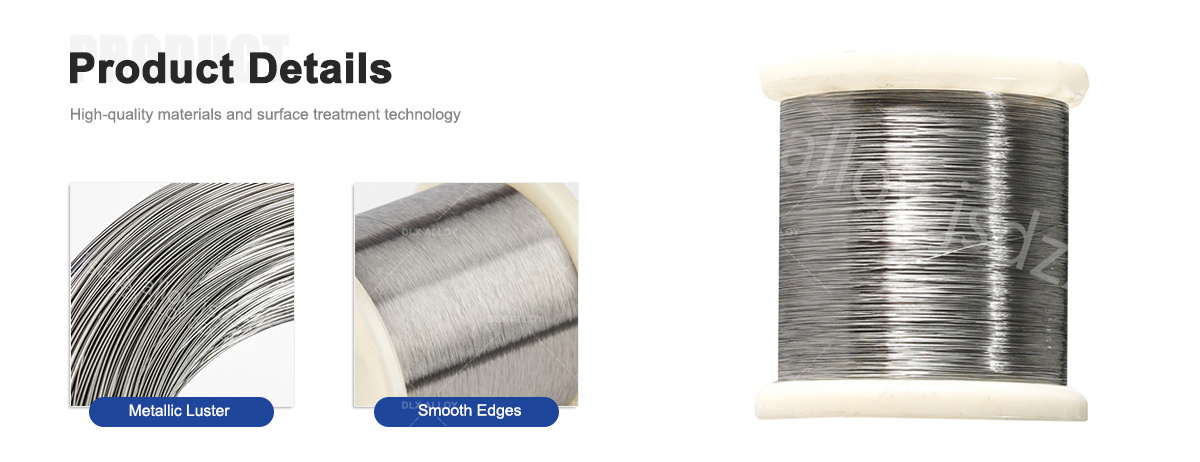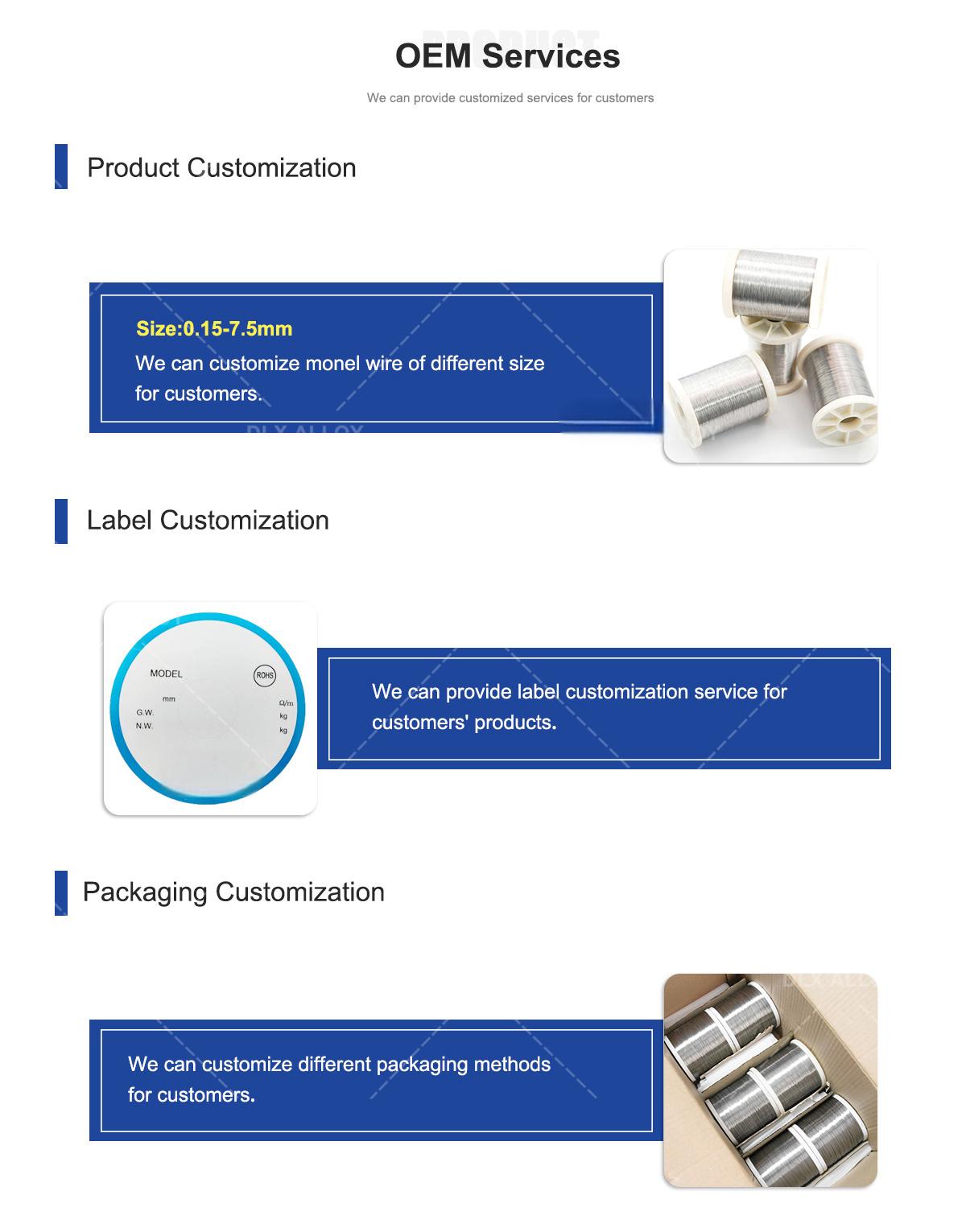 0
0
Products Description

Monel wire is a high-performance nickel-copper alloy wire that is widely used in different fields. Known for its excellent corrosion resistance, high temperature performance and mechanical properties, it is widely used in petrochemical, marine engineering, aerospace and other industries. Monel wire can resist the erosion of acidic, alkaline and salty media and maintain stable performance in high temperature and high pressure environments. Its high strength, good plasticity and weldability make it ideal for manufacturing key components such as corrosion-resistant equipment, valves, pipelines and more.
Parameter

Item | Ni | Cu | Fe | Mn | C | Si | S |
Monel 400 | ≥63 | 28-34 | ≤2.5 | ≤2 | ≤0.3 | ≤0.5 | ≤0.025 |
Item | Ni | Cu | Al | Ti | Fe | Mn | S | C | Si |
Monel K500 | ≥63 | 27-33 | 2.3-3.15 | 0.35-0.85 | ≤2 | ≤1.5 | ≤0.01 | ≤0.25 | ≤0.5 |
Item | Density | Melting point | Tensile Strength | Yield Strength | Elongation | HB |
Monel 400 | 8.83 g/cm3 | 1300-1390℃ | 480 | 170 | 35% | ≥331 |
Item | Density | Melting point | Tensile Strength | Yield Strength | Elongation |
Monel K500 | 8.05 g/cm3 | 1288-1343℃ | 1100 | 790 | 20% |
Monel 400 | Bar / Rod | Forging | Pipe | Sheet / Strip | Welding Wire |
Standard | ASTM B164 | ASTM B564 | ASTM B165 | ASTM B127 | ErNiCu-7 |
Monel K500 | Bar/Rod | Forging | Pipe | Sheet/Strip | Welding Wire |
Standard | ASTM B864 | AMS4676 | ASTM B865 | ASTM B564 | ErNiCu-7 |
For more details, pls directly contact us.

Mechanical properties

Monel wire is a high-strength, highly corrosion-resistant alloy wire material, mainly composed of nickel and copper, usually containing small amounts of iron, manganese, carbon and other elements. Regarding the mechanical properties of Monel wire:
Strength: Monel wire has high strength, and its tensile strength is usually between 690 MPa (MPa) and 1035 MPa. This makes Monel wire ideal for applications requiring high-strength materials.
Extensibility: Despite its high strength, Monel wire is also quite extensible. Its yield strength is usually between 345 MPa and 690 MPa. It has a certain degree of plasticity and can undergo a certain degree of plastic deformation during the stress process.
Hardness: Monel wire has moderate hardness, usually expressed by Rockwell hardness (HRC) or Brinell hardness (HB). Hardness depends on the alloy's formulation and heat treatment process.
Toughness: Monel wire maintains a certain toughness between high strength and high corrosion resistance. It can maintain relatively stable performance when subjected to shock or vibration loads and has certain resistance to stress corrosion cracking.
Fatigue resistance: Monel wire has good fatigue resistance and can maintain stable performance under cyclic or alternating loads. This makes it suitable for applications requiring long-term use and often subject to dynamic loads.
Heat treatment process

The heat treatment process of Monel wire has an important impact on its mechanical properties. Appropriate heat treatment can change the crystal structure, phase composition and physical properties of the alloy, thus having a significant impact on its mechanical properties. The following are some common heat treatment processes and their impact on the mechanical properties of Monel wire:
Solution Annealing: Solution Annealing is to heat the Monel wire to the solid solution temperature of the alloy and then cool it rapidly to form a uniform solid solution. Solid solution treatment can eliminate the supersaturated solid solution phase of the alloy, improve the ductility and plasticity of the alloy, and reduce the tendency of stress corrosion.
Aging: Aging treatment is to heat the Monel wire to a temperature lower than the solid solution temperature after solution treatment, and then cool it after maintaining it for a certain period of time. Aging treatment can lead to the formation of precipitated phases in the alloy, further improving the strength and hardness of the alloy. The selection of aging treatment time and temperature is crucial to the control of final mechanical properties.
Cold Working and Annealing: The strength and hardness of Monel wire can be increased through cold working (such as cold drawing or cold rolling), but its elongation will also be reduced. To restore ductility and reduce stress, annealing is often required. Annealing will improve the plasticity and toughness of the alloy, reduce internal stress, and make the alloy more suitable for processing and use.
Cooling rate control: During the heat treatment of Monel wire, cooling rate control will also have an impact on the mechanical properties. Rapid cooling (such as water quenching or gas cooling) can result in higher strength and hardness but may reduce extensibility. Slow cooling (such as furnace cooling) can improve toughness and extensibility but may reduce strength and hardness.
Annealing treatment

Annealing treatment has the following specific effects on the mechanical properties of Monel wire:
Improvement of plasticity and toughness: Annealing treatment can eliminate the strain and internal stress introduced during cold working, allowing the crystal structure of Monel wire to be restored and restructured. This improves the plasticity and toughness of the alloy, making it easier to deform and ductile, and reducing its tendency to become brittle.
Reduction in strength and hardness: Annealing treatment will cause the crystal structure of Monel wire to rearrange, move grain boundaries and grow grains. This reduces the strength and hardness of the alloy, making it softer. This can be beneficial in certain applications, such as where resistance to deformation or impact is required.
Homogenization of the structure: Annealing helps eliminate or reduce segregation and inhomogeneity of phase distribution in the alloy. This can achieve a more uniform microstructure, improve the uniformity and consistency of the alloy, and thereby improve its mechanical properties.
Reduction of stress and stress corrosion tendencies: Annealing helps reduce residual stress inside the Monel wire, making it more stable and reliable. Annealing can also reduce the stress corrosion tendency of the alloy and improve its corrosion resistance.
The specific impact of the annealing treatment depends on parameters such as annealing temperature, holding time and cooling method. Higher annealing temperatures and longer holding times usually lead to larger grain growth and tissue recovery, thereby reducing strength and hardness. Different annealing treatment conditions can be optimized based on specific application requirements and alloy properties.

FAQ

Q: What is the use of Monel wire in marine engineering?
A: In marine engineering, Monel wire is often used to manufacture seawater treatment equipment, seawater pumps, ship parts, etc. to cope with harsh marine environments and saline media.
Q: Does Monel wire have good corrosion resistance in acidic environment?
A: Yes, Monel wire shows excellent corrosion resistance in acidic environments and can resist the erosion of acidic media.
Q: What is the conductivity of Monel wire?
A: Monel wire has good electrical conductivity and can be used in applications that require conductive properties.
E-mail: Info@hulkalloy.com
Mobile: 0086 13852926463
Tel: 0086 13852926463
Whatapps: 0086 13852926463
Add: Renli Village, Fangxian Town, Danyang City, Jiangsu Province, China